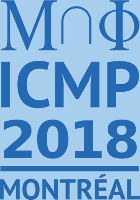Mécanique statistique à l'équilibre
- Clément Hongler (EPFL, Lausanne)
- Daniel Ueltschi (Univeristy of Warwick)
- Mardi 24 juil [mont royal i & ii]
- 16:30 Serena Cenatiempo (Gran Sasso Science Institute), Bogoliubov theory in the Gross-Pitaevskii regime
- 17:00 Dmitry Chelkak (Ecole Normale Supérieure), Tau-functions à la Dubédat and cylindrical events in the double-dimer model
- 17:30 Nicholas Crawford (The Technion, Haifa), Eigenvector Correlations for the Ginibre Ensemble
- 18:00 Aukosh Jagannath (Harvard University Science Center), Spectral Gap estimates in mean field spin glasses
- Mercredi 25 juil [mont royal i & ii]
- 15:15 Marcin Napiórkowski (University of Warsaw), Bogoliubov Theory at Positive Temperatures
- 15:45 Eveliina Peltola (Université de Genève), On multiple SLEs
- Serena Cenatiempo
Gran Sasso Science InstituteBogoliubov theory in the Gross-Pitaevskii regimeSince 1947 Bogoliubov theory has represented the guide model to thinking about Bose gases. Such a theory predicts a linear excitation spectrum and provides expressions for the thermodynamic functions which are believed to be correct in the dilute limit. Remarkably, there are only a few cases where the predictions of Bogoliubov theory can be actually proved. In particular, one of the main mathematical issues is to recover the intuition that the physical parameter that should appear in the expressions for the physical quantities is the scattering length of the interaction.
In this talk I will discuss how the predictions of Bogolibov theory can be rigorously obtained for a system of $N$ bosons trapped in a box with volume one and interacting through a weak, repulsive potential with scattering length $1/N$ (Gross-Pitaevskii regime). This is a joint work with C. Boccato, C. Brennecke and B. Schlein.
- Dmitry Chelkak
Ecole Normale SupérieureTau-functions à la Dubédat and cylindrical events in the double-dimer modelBuilding on the results of Dubédat on convergence of topological correlators in the double-dimer model to isomonodronic tau-functions, we discuss the convergence of probabilities of cylindrical events. Namely, for any collection of punctures of a simply connected domain and a sequence of its Temperley discretizations, we show that the probability to see a given macroscopic lamination – i.e., a given homotopy class of the collection of loops surrounding at least two punctures – in a sample of the double-dimer model converges in the small mesh size limit (to the same probability evaluated for CLE(4)). Based on a joint work with Mikhail Basok (St.Petersburg).
- Nicholas Crawford
The Technion, HaifaEigenvector Correlations for the Ginibre EnsembleThe complex Ginibre ensemble is an $N\times N$ non-Hermitian random matrix over $\mathbb{C}$ with i.i.d. complex Gaussian entries normalized to have mean zero and variance $1/N$. Unlike the Gaussian unitary ensemble, for which the eigenvectors are distributed according to Haar measure on the compact group $U(N)$, independently of the eigenvalues, the geometry of the eigenbases of the Ginibre ensemble are not particularly well understood. In this talk I will explain recent work with Ron Rosenthal in which we systematically study properties of eigenvector correlations in this matrix ensemble. We uncover an extended algebraic structure which describes their asymptotic behavior (as $N$ goes to infinity). Our work extends previous results of Chalker and Mehlig, in which the correlation for pairs of eigenvectors was computed.
- Aukosh Jagannath
Harvard University Science CenterSpectral Gap estimates in mean field spin glassesA central prediction in the study of spin glasses is that for any local reversible dynamics, one expects an exponential time to equilibrium in the spin glass phase. We prove this prediction for a broad class of Ising spin and spherical spin glass models. We present a single framework to prove these estimates that applies equally in the discrete and manifold settings by formalizing the notion of ``free energy barriers’’ whose presence imply exponentially slow mixing. We then present sufficient conditions which imply the existence of these barriers for a large class of mean field spin glass models using the notions of the ``replicon eigenvalue’’, the 2D Guerra—Talagrand bounds, and a quenched LDP for the overlap distribution. We these sufficient conditions cover large classes of spin glass models, e.g., p-spin models. I will report on two recent joint works with G. Ben Arous (NYU) and R. Gheissari (NYU). - Marcin Napiórkowski
University of WarsawBogoliubov Theory at Positive TemperaturesI shall discuss the homogeneous Bose gas at positive temperatures within Bogoliubov theory. The theory arises by restricting the Hilbert space to quasi-free states. I will introduce the free energy functional and discuss the existence of equilibrium states, phase diagram and critical temperature. This is joint work with Robin Reuvers and Jan Philip Solovej.
- Eveliina Peltola
Université de GenèveOn multiple SLEsWe discuss conformally invariant measures on families of curves known as multiple Schramm-Loewner evolutions, that naturally correspond to interfaces in critical planar lattice models with alternating (”generalized Dobrushin”) boundary conditions. These measures are uniquely characterized by a natural cascade property. They are also closely related to scaling limits of connection probabilities in critical planar lattice models.
The talk is based on joint works with Hao Wu (Yau Mathematical Sciences Center, Tsinghua University) and Vincent Beffara (Université Grenoble Alpes, Institut Fourier).


